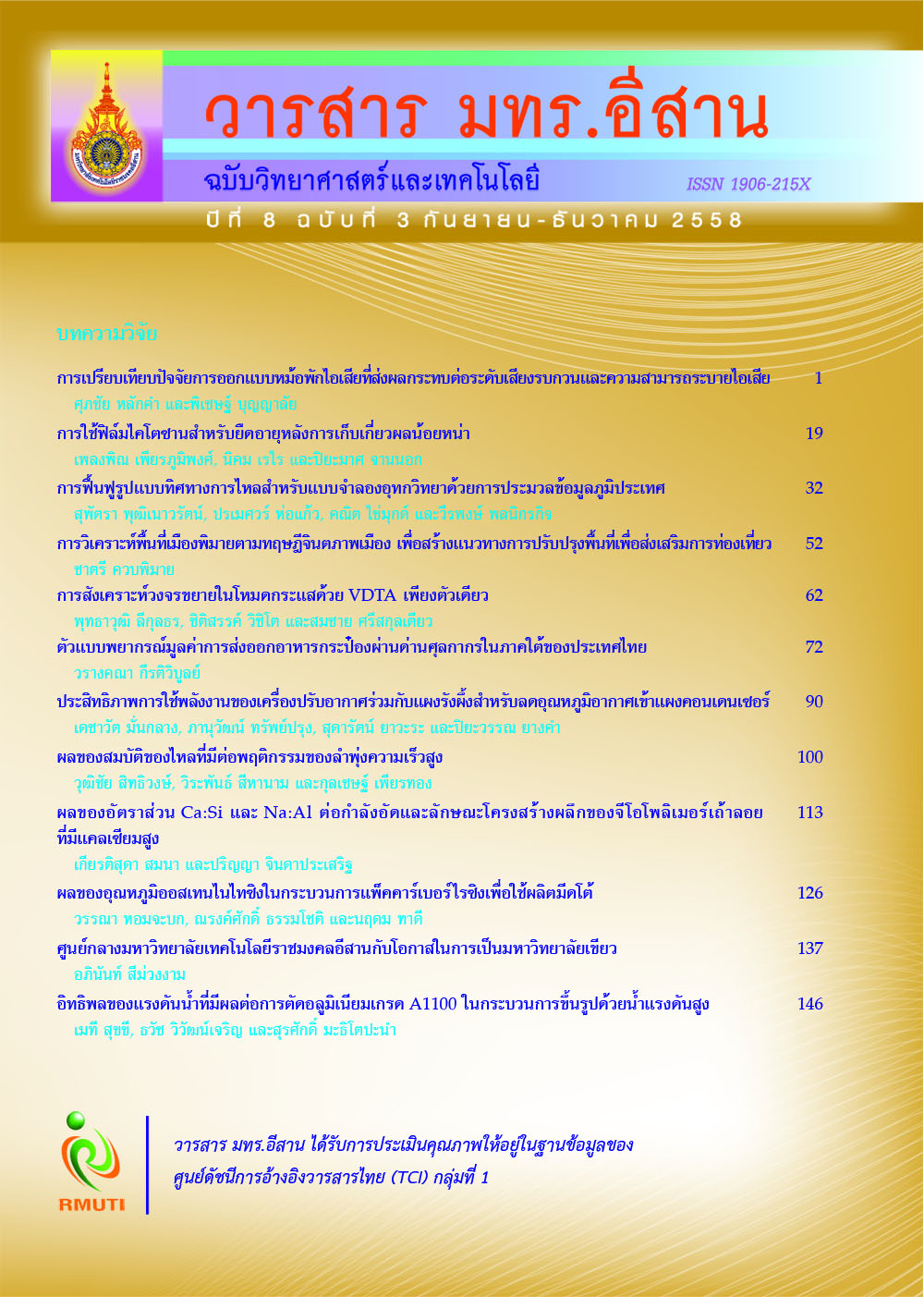ผลของอัตราส่วน Ca:Si และ Na:Al ต่อกำลังอัดและลักษณะโครงสร้างผลึก ของจีโอโพลิเมอร์เถ้าลอยที่มีแคลเซียมสูง Effect of Ca:Si and Na:Al Ratio on Compressive Strength and Microstructure of High Calcium Fly Ash Geopolymer
Main Article Content
Abstract
บทคัดย่อ
งานวิจัยนี้ศึกษาถึงผลของอัตราส่วน Ca:Si และ Na:Al ของส่วนผสมจีโอโพลิเมอร์ต่อกำลังอัดและ
ลักษณะโครงสร้างทางจุลภาคของจีโอโพลิเมอร์เถ้าลอยที่มีแคลเซียมสูง มีวัตถุประสงค์เพื่อเป็นแนวทาง
ในการออกแบบส่วนผสมจีโอโพลิเมอร์ที่เหมาะสมและมีคุณสมบัติทางกลที่ดี วัสดุตั้งต้นที่ใช้ในการศึกษา
ได้แก่ เถ้าถ่านหินที่มีแคลเซียมออกไซด์สูงและไมโครซิลิกา ใช้สารละลายโซเดียมไฮดรอกไซด์ที่ความเข้มข้น
10 15 และ 18 โมลาร์ แทนที่เถ้าถ่านหินด้วยไมโครซิลิการ้อยละ 0 5 10 20 และ 30 โดยนํ้าหนัก
เพื่อให้มีการแปรเปลี่ยนค่าอัตราส่วน Ca:Si และ Na:Al ศึกษากำลังอัดที่อายุ 28 วัน และลักษณะ
โครงสร้างทางจุลภาคด้วยเทคนิค XRD พบว่าอัตราส่วน Na:Al ควรควบคุมให้มีค่าอยู่ในช่วง 1.41 ถึง
1.78 เพื่อให้สามารถรับค่ากำลังอัดได้ดี การใช้อัตราส่วน Ca:Si ที่ให้ค่ากำลังอัดที่ดีขึ้นอยู่กับร้อยละ
การแทนที่เถ้าถ่านหินด้วยไมโครซิลิกาและความเข้มข้นของโซเดียมไฮดรอกไซด์ที่ใช้ ดังนั้น ปัจจัยร่วม
ที่ทำให้จีโอโพลิเมอร์รับกำลังได้ดี ได้แก่ ชนิดของวัสดุตั้งต้น ความเข้มข้นของโซเดียมไฮดรอกไซด์
ร้อยละการแทนที่ของไมโครซิลิกาและอัตราส่วนสารละลายต่อวัสดุประสาน (W/B ratio)
Abstract
This research studied effects of Ca:Si and Na:Al ratio on compressive strength and
microstructure of high calcium geopolymer. The objective is to guide the mix proportion
of geoplymer to provide good mechanical properties. Fly ash with high calcium
content and microsilica were selected to be starting materials. Concentration of sodium
hydroxide solutions at 10, 15 and 18 molar were used. Microsilica was partially replaced
fly ash at 0, 5, 10, 20 and 30% by weight of binder. The compressive strength of
geopolymer pastes were investigated at the age of 28 days while microstructure of
pastes was characterized by XRD technique. It was found that the ratio of Na:Al between
1.41 and 1.78 gave a good compressive strength results. Using Ca:Si ratio in geopolymer
which provided high compressive strength was depended on percent replacement of
silica and NaOH concentration. Thus, the factors effect of geopolymer to obtain high
compressive strength were starting material, NaOH concentration, percent replacement
of silica source and water to binder ratio.
Article Details
References
for coal fly ash and raw or calcined natural pozzolan for use inconcrete. Annual
Book of ASTM Standards. Philadelphia. 04.02.2008
Chindaprasirt. P., Chareerat. T. and Sirivivananon. V. (2007). Workability and strength
of coarse high calcium fly ash geopolymer. Cement and Concrete Composites.
Vol. 29. Issue 3. pp. 224-229
Chindaprasirt, P., Chareerat, T., Hatanaka, S. and Cao, T. (2011). High-strength
geopolymer using fine high-calcium fly ash. ASCE Journal of Materials in
Civil Engineering. Vol. 23. No. 3. pp. 264-270
Davidovits, J. (1999). Chemistry of geopolymer systems, terminology. In Proceedings
Second International Conference. Geopolymer’99 Institut Geopolymer.
Saint-Quentin. France. pp. 9-39
Davidovits, J. (2008). Geopolymer Chemistry & Application. France: Institute Geopolymer
Lee, W. K. W. and Van Deventer, J. S. J. (2002). Structural reorganization of class F fly ash
in alkaline silicate solutions. Colloids and Surfaces A: Physicochem. Eng.
Aspects. Vol. 211. pp. 49-66
Phair, J. W. and Van Deventer, J. S. J. (2002). Characterisation of fly-ash based geopolymeric
binders activated with sodium aluminate. Industrial & Engineering Chemistry
Research. Vol. 41. No. 17. pp. 4242-4251
Sata. V., Wongsa. A. and Chindaprasirt. P. (2013). Properties of pervious geopolymer
concrete using recycled aggregates. Construction and Building Materials. Vol. 42.
pp. 33-39
Yip, C. K. Lukey, G. C. and Van Deventer, J. S. J. (2005). The coexistence of geopolymer
gel and calcium silicate hydrate at the early stage of alkaline activation. Cement
and Concrete Research. Vol. 35. pp. 1688-1697
Somna. K., Jaturapitakkul. C., Kajitvichyanukul. P. and Chindaprasirt. P. (2011).
NaOH-activated ground fly ash geopolymer cured at ambient temperature.
Fuel. Vol. 90. No. 6. pp. 2118-2124
Van Jaarsveld, J. G. S. and Van Deventer, J. S. J. (1999). Effect of the alkali metal
activator on the properties of y-ash-based geopolymers. Industrial & Engineering
Chemistry Research. Vol. 38. No. 10. pp. 3932-3941
De Silva P, Sagoe-Crenstil K and Sirivivatnanon V. (2007). Kinetics of geopolymerization :
role of Al24O3 and SiO2. Cement and Concrete Research. Vol. 37. No. 4. pp. 512-518
Zuhua, Z., Xiao, Y., Huajun, Z. and Yue C. (2009). Role of water in the synthesis of
calcined kaolin-based geopolymer. Applied Clay Science. Vol. 43. No. 2. pp. 218-23
Suresh Thokchom, Debabrata Dutta and Somnath Ghosh. (2011). Effect of Incorporating
Silica Fume in Fly Ash Geopolymers. World Academy of Science. Engineering and
Technology. Vol. 60. pp. 243-247


